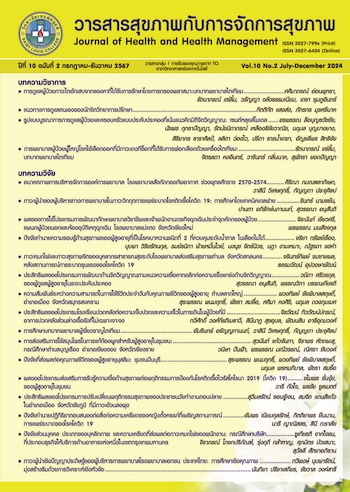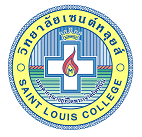Factors predicting the Reaction to Stressors of Pregnant Women Encountering COVID-19
Keywords:
Stressors, Reaction to stressors, COVID-19 outbreak, Pregnant women, predictive factorsAbstract
The objective of this research is to study the reaction to stressors and factors predicting the reaction to stressors of pregnant women encountering COVID-19. The sample group consisted of 120 pregnant women aged 20-45, selected through multiple stage sampling. The research tools included basic demographic information, intrapersonal stressors, interpersonal stressors, external stressors, and the reaction to stressors questionnaires, with Cronbach’s alpha reliability coefficients of 0.89. Data analysis was conducted using descriptive statistics and stepwise multiple regression analysis. The results revealed that the overall of the reaction to stressor was at a high level (M = 3.67, SD = 0.62), and significant predictors of reaction to stressors in pregnant women during the COVID-19 were intrapersonal stressors, education level, and the number of pregnancies, accounting for 38.1% (R2= .381) of the variance in the reaction to stressors, with statistical significance at the .05 level. These findings can be used to inform the planning of care and support for pregnant women facing new infectious diseases, to reduce the risk of stress, improve coping mechanisms, and enhance overall health outcomes for pregnant women.
References
กรกนก เกื้อสกุล. (2564). วิถีใหม่ในการดูแลสุขภาพหญิงตั้งครรภ์ช่วงสถานการณ์ COVID-19. สืบค้นจาก https://www.posttoday.com/politic/columnist/650197
กาญจนา ศรีสวัสดิ์ และชุติมา ปัญญาพินิจนุกูร. (2559). ความเครียดในหญิงตั้งครรภ์วัยรุ่น. วารสารพยาบาลทหารบก, 17(2), 7-11.
ขวัญตา บุญวาศ, ศศิธร คาพันธ์, และชุติกาญจน์ แซ่ตั้น. (2559). ปัจจัยที่ส่งผลต่อระดับความเครียดของหญิงตั้งครรภ์วัยรุ่น. วารสารวิทยาลัยพยาบาลบรมราชชนนีกรุงเทพ, 32(3), 1-10.
เนตรรัชนี กมลรัตนานันท์, นิรัตน์ชฎา ไชงาม, ศรีสุดา วงศ์วิเศษกุล, และกิติวัฒนา ศรีวงศ์. (2563). การเลี้ยงลูกด้วยนมแม่ในช่วงวิกฤตโควิด 19. วารสารเกื้อการุณย์, 27(2), 175-185.
เบญจวรรณ ละหุการ, วลัยลักษณ์ สุวรรณภักดี, ทัศณีย์ หนูนารถ, และมลิวัลย์ บุตรดำ. (2563). ความเครียดในหญิงตั้งครรภ์ที่มีภาวะเจ็บครรภ์คลอดก่อนกำหนด. วารสารมหาจุฬานาครทรรศน์, 7(10), 1-14.
ผกามาศ เชยกลิ่น, นารีรัตน์ บุญเนตร, และตติรัตน์ เตชะศักดิ์ศร. (2566). ปัจจัยที่มีอิทธิพลต่อความวิตกกังวลของหญิงตั้งครรภ์ในสถานการณ์การแพร่ระบาดของโควิด 19. วารสารไทยเภสัชศาสตร์และวิทยาการสุขภาพ, 18(1), 60-69.
รุจา แก้วเมืองฝาง, บุญตา สุขวดี, มนัสชนกฑ์ กุลพานิชย์, พิมพ์ลดา อนันต์สิริเกษม, และสุภาพร ปรารมย์. (2563). การพยาบาลหญิงตั้งครรภ์ที่ติดเชื้อโควิด 19. วารสารมหาจุฬานาครทรรศน์, 7(11), 370-383.
ศรีพรรณ กันธวัง. (2551). ทฤษฎีระบบของนิวแมน: การนำไปใช้ในการปฏิบัติการพยาบาล. เชียงใหม่: คณะพยาบาลศาสตร์ มหาวิทยาลัยเชียงใหม่
อรทัย แซ่ตั้ง, จรรยา แก้วใจบุญ, และฐิติพร เรือนกุล. (2564). ความเครียดและปัจจัยที่เกี่ยวข้องต่อความเครียดของหญิงตั้งครรภ์อายุมาก. วารสารวิจัยการพยาบาลและสุขภาพ, 22(3), 71-83.
Faul, F., Erdfelder, E., Buchner, A., & Lang, A. G. (2009). Statistical power analyses using G* Power 3.1: Tests for correlation and regression analyses. Behavior research methods, 41(4), 1149-1160.
Hobel, C. J., Goldstein, A. M. Y., & Barrett, E. S. (2008). Psychosocial stress and pregnancy outcome. Clinical obstetrics and gynecology, 51(2), 333-348.
Ilska, M., Brandt-Salmeri, A., Kołodziej-Zaleska, A., Preis, H., Rehbein, E., & Lobel, M. (2022). Anxiety among pregnant women during the first wave of the COVID-19 pandemic in Poland. Scientific Reports, 12(1), 8445.
Keenan, K., Sheffield, R., & Boeldt, D. (2007). Are prenatal psychological or physical stressors associated with suboptimal outcomes in neonates born to adolescent mothers?. Early human development, 83(9), 623-627.
Moyer, C. A., Compton, S. D., Kaselitz, E., & Muzik, M. (2020). Pregnancy-related anxiety during COVID-19: a nationwide survey of 2740 pregnant women. Archives of women’s mental health, 23(6), 757-765.
Neuman, B., & Fawcett, J. (2002). The Neuman Systems Model (4th ed.). Upper Saddle River, New Jersey: Prentice Hall.
Polit, D. F., & Beck, C. T. (2012). Nursing research:Generating and assessing evidence for nursing practice (9th ed.). New York: J. B. Lippincott.
Sandman, C. A., Wadhwa, P. D., Chicz-Demet, A., Dunkel-Schetter, C., & Porto, M. (1997). Maternal stress, HPA activity, and fetal/infant outcome. Annals of the New York Academy of Sciences, 814, 266-275.
Schoch-Ruppen, J., Ehlert, U., Uggowitzer, F., Weymerskirch, N., & La Marca- Ghaemmaghami, P. (2018). Women’s word use in pregnancy: Associations with maternal characteristics, prenatal stress, and neonatal birth outcome. Frontiers in Psychology, 9, 1234. doi: 10.3389/fpsyg.2018.01234
Downloads
Published
How to Cite
Issue
Section
License
Copyright (c) 2024 Journal of health and health management

This work is licensed under a Creative Commons Attribution-NonCommercial-NoDerivatives 4.0 International License.




